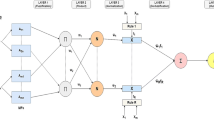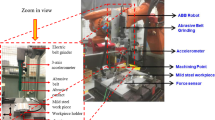Abstract
Optimizing the parameters in the milling method is important in terms of cost, energy, and time. The forces that arise during milling cause undesirable results, such as tool wear and energy loss. In this study, cutting parameters were optimized during the milling of AISI 321 material. Cutting speed (60, 70, 80 m/min), feed per tooth (0.04, 0.05, 0.06 mm/tooth), and depth of cut (0.25, 0.5, 0.75 mm) were selected as input parameters. Cutting force in the X and Y axes and the surface roughness were selected as the output parameters. Optimum parameters (60.80 m/min for cutting speed, 0.04 mm/tooth for feed per tooth, and 0.25 mm for depth of cut) were found using response surface methodology. The effect of cutting parameters was calculated by analysis of variance. The most influential parameters were found, depth of cut as 87.49% for cutting force on the X-axis, 86.48% on the Y-axis, and for surface roughness, the cutting speed with 36.48%. Prediction models are compared to choose the best model. Individual (Neural network, decision tree, and k-nearest neighbor algorithms) and ensemble methods (vote) from machine learning and response surface methodology from statistical methods were used for models. The error rates of the models were compared according to the mean absolute percentage error performance criterion. The lowest MAPE values were obtained with the vote method 11.163% in the X-axis force, the artificial neural network algorithm with 7.749% in the Y-axis force, and RSM with 0.93% in the surface roughness.











Similar content being viewed by others
Abbreviations
- RSM:
-
Response surface methodology
- ANOVA:
-
Analysis of variance
- MAPE:
-
Mean absolute percentage error
- ANN:
-
Artificial neural network
- SVR:
-
Support vector regression
- DT:
-
Decision tree
- K-NN:
-
K-nearest neighbor
- F x :
-
X-axis force (N)
- F y :
-
Y-axis force (N)
- Ra:
-
Surface roughness (µm)
- Vc:
-
Cutting speed (m/min)
- fz:
-
Feed per tooth (mm/tooth)
- Ap:
-
Depth of cut (mm)
- HB:
-
Brinell hardness
- MLP:
-
Multilayer perceptron neural network
- DF:
-
Degree of freedom
- Adj SS:
-
Adjusted sum of squares
- Adj MS:
-
Adjusted mean squares
References
Gale, W.F.; Totemeier, T.C.: Smithells Metals Reference Book. Heinemann, Butterworth (2004)
Zhaohui, D.; Lishu, L.; Wenliang, H.; Linlin, W.; Shichun, L.: Modelling of carbon utilisation efficiency and its application in milling parameters optimization. Int. J. Prod. Res. (2020). https://doi.org/10.1080/00207543.2019.1633026
Anburaj, R.; Kumar, M.P.: Experimental studies on cryogenic CO2 face milling of inconel 625 superalloy. Mater. Manuf. Processes (2020). https://doi.org/10.1080/10426914.2020.1866199
Bag, R.; Panda, A.; Sahoo, A.K., et al.: Sustainable high-speed hard machining of AISI 4340 steel under dry environment. Arab. J. Sci. Eng. (2022). https://doi.org/10.1007/s13369-022-07094-9
Selvakumar, S.; Sreebalaji, V.S.; Ravikumar, K.: Machinability analysis and optimization in micro turning on tool wear for titanium alloy. Mater. Mater Manuf. Processes (2021). https://doi.org/10.1080/10426914.2020.1866198
Siddiquee, A.N.; Khan, Z.A.; Goel, P.; Kumar, M.; Agarwal, G.; Khan, N.Z.: Optimization of deep drilling process parameters of AISI 321 steel using taguchi method. Proc. Mater. Sci. (2014). https://doi.org/10.1016/j.mspro.2014.07.195
Vereschaka, A.A.; Grigoriev, S.; Sitnikov, N.N.; Bublikov, J.I.; Batako, A.D.L.: Effect produced by thickness of nanolayers of multilayer composite wear-resistant coating on tool life of metal-cutting tool in turning of steel AISI 321. Proc. CIRP (2018). https://doi.org/10.1016/j.procir.2018.08.236
Pekşen, H.; Kalyon, A.: Optimization and measurement of flank wear and surface roughness via Taguchi based grey relational analysis. Mater. Manuf. Processes (2021). https://doi.org/10.1080/10426914.2021.1926497
Ross, N.S.; Sheeba, P.T.; Jebaraj, M.; Stephen, H.: Milling performance assessment of Ti–6Al–4V under CO2 cooling utilizing coated AlCrN/TiAlN insert. Mater. Manuf. Processes (2021). https://doi.org/10.1080/10426914.2021.2001510
Li, B.; Zhang, S.; Fang, Y.; Wang, J.; Lu, S.: Effects of cutting parameters on surface quality in hard milling. Mater. Manuf. Processes (2019). https://doi.org/10.1080/10426914.2019.1675888
Zhang, H.P.; Ding, C.L.; Shi, R.X.; Liu, R.H.: Optimization of technological parameters and application conditions of CMQL in high-speed milling 300M steel. Integr. Ferroelectr. (2021). https://doi.org/10.1080/10584587.2021.1911306
Choudhury, M.R.; Rao, G.S.; Debnath, K.; Mahapatra, R.N.: Analysis of force, temperature, and surface roughness during end milling of green composites. J. Nat. Fibers (2021). https://doi.org/10.1080/15440478.2021.1875350
Zhang, X.; Yu, T.; Li, M.; Wang, Z.: Effect of machining parameters on the milling process of 2.5 DC/SiC ceramic matrix composites. Mach. Sci. Technol. (2020). https://doi.org/10.1080/10910344.2019.1636271
Çakıroğlu, R.: Machinability analysis of inconel 718 superalloy with AlTiN-coated carbide tool under different cutting environments. Arab. J. Sci. Eng. (2021). https://doi.org/10.1007/s13369-021-05626-3
Karabulut, Ş; Çinici, H.; Karakoç, H.: Experimental investigation and optimization of cutting force and tool wear in milling Al7075 and open-cell SiC foam composite. Arab. J. Sci. Eng. (2016). https://doi.org/10.1007/s13369-015-1991-4
Badiger, P.V.; Desai, V.; Ramesh, M.R., et al.: Cutting forces, surface roughness and tool wear quality assessment using ANN and PSO approach during machining of MDN431 with TiN/AlN-coated cutting tool. Arab. J. Sci. Eng. (2019). https://doi.org/10.1007/s13369-019-03783-0
Abbas, A.T.; Pimenov, D.Y.; Erdakov, I.N., et al.: Optimization of cutting conditions using artificial neural networks and the Edgeworth-Pareto method for CNC face-milling operations on high-strength grade-H steel. Int. J. Adv. Manuf. Technol. (2019). https://doi.org/10.1007/s00170-019-04327-4
Jurkovic, Z.; Cukor, G.; Brezocnik, M.; Brajkovic, T.A.: Comparison of machine learning methods for cutting parameters prediction in high speed turning process. J. Intell. Manuf. (2018). https://doi.org/10.1007/s10845-016-1206-1
Sun, Y.; Yang, G.; Wen, C.; Zhang, L.; Sun, Z.: Artificial neural networks with response surface methodology for optimization of selective CO2 hydrogenation using K-promoted iron catalyst in a microchannel reactor. J. CO2 Util. (2018). https://doi.org/10.1016/j.jcou.2017.11.013
Daniel, S.A.A.; Pugazhenthi, R.; Kumar, R.; Vijayananth, S.: Multi objective prediction and optimization of control parameters in the milling of aluminium hybrid metal matrix composites using ANN and Taguchi -grey relational analysis. Defence Technol. (2019). https://doi.org/10.1016/j.dt.2019.01.001
Segreto, T.; D’Addona, D.; Teti, R.: Tool wear estimation in turning of Inconel 718 based on wavelet sensor signal analysis and machine learning paradigms. Prod. Eng. (2020). https://doi.org/10.1007/s11740-020-00989-2
Pimenov, D.Y.; Bustillo, A.; Mikolajczyk, T.: Artificial intelligence for automatic prediction of required surface roughness by monitoring wear on face mill teeth. J. Intell. Manuf. (2018). https://doi.org/10.1007/s10845-017-1381-8
Balasubramanian, A.N.; Yadav, N.; Tiwari, A.: Analysis of cutting forces in helical ball end milling process using machine learning. Mater. Today Proc. (2021). https://doi.org/10.1016/j.matpr.2020.02.098
Correa, M.; Bielza, C.; Ramirez, M.D.J.; Alique, J.R.: A Bayesian network model for surface roughness prediction in the machining process. Int. J. Syst. Sci. (2008). https://doi.org/10.1080/00207720802344683
Gupta, A.K.: Predictive modeling of turning operations using response surface methodology, artificial neural networks, and support vector regression. Int. J. Prod. Res. (2010). https://doi.org/10.1080/00207540802452132
Pimenov, D.Y.; Abbas, A.T.; Gupta, M.K., et al.: Investigations of surface quality and energy consumption associated with costs and material removal rate during face milling of AISI 1045 steel. Int. J. Adv. Manuf. Technol. (2020). https://doi.org/10.1007/s00170-020-05236-7
Natarajan, C.; Muthu, S.; Karuppuswamy, P.: Investigation of cutting parameters of surface roughness for brass using artificial neural networks in computer numerical control turning. Aust. J. Mech. Eng. (2012). https://doi.org/10.1080/14484846.2012.11464616
https://www.azom.com/article.aspx?ArticleID=967 Accessed 10 Nov 2022.
Kuntoğlu, M.; Aslan, A.; Sağlam, H.; Pimenov, D.Y.; Giasin, K.; Mikolajczyk, T.: Optimization and analysis of surface roughness, flank wear and 5 different sensorial data via tool condition monitoring system in turning of AISI 5140. Sensors (2020). https://doi.org/10.3390/s20164377
Şap, E.; Usca, Ü.A.; Gupta, M.K.; Kuntoğlu, M.; Sarıkaya, M.; Pimenov, D.Y.; Mia, M.: Parametric optimization for improving the machining process of cu/mo-sicp composites produced by powder metallurgy. Materials (2021). https://doi.org/10.3390/ma14081921
Kuntoğlu, M.; Aslan, A.; Pimenov, D.Y.; Giasin, K.; Mikolajczyk, T.; Sharma, S.: Modeling of cutting parameters and tool geometry for multi-criteria optimization of surface roughness and vibration via response surface methodology in turning of AISI 5140 steel. Materials (2020). https://doi.org/10.3390/ma13194242
Mang, D.Y.; Abdou, A.B.; Njintang, N.Y., et al.: Application of desirability-function and RSM to optimize antioxidant properties of mucuna milk. Food Meas. (2015). https://doi.org/10.1007/s11694-015-9258-z
Hazir, E.; Ozcan, T.: Response surface methodology integrated with desirability function and genetic algorithm approach for the optimization of CNC machining parameters. Arab. J. Sci. Eng. (2019). https://doi.org/10.1007/s13369-018-3559-6
Torgo, L.; Ribeiro, R.P.; Pfahringer, B.; Branco, P.: SMOTE for Regression. In: Correia L., Reis L.P., Cascalho J. (eds.) Progress in Artificial Intelligence. EPIA 2013. Lect. Notes Comput. Sci (2013). https://doi.org/10.1007/978-3-642-40669-0_33
Kuncheva, I.L.: Combining Pattern Classifiers. Wiley, New Jersey (2004) https://doi.org/10.1002/0471660264
Öztemel, E.: Yapay Sinir Ağları, 1st edn. Papatya Yayınları, Istanbul (2003)
Mitchell, T.M.: Machine Learning, 1st edn. McGraw-Hill Science, New York (1997)
Jiawei, H.; Micheline, K.; Jian, P.: Data Mining: Concepts and Techniques. Elsevier, Waltham (2012) https://doi.org/10.1016/C2009-0-61819-5
Li, Z.; Ma, W.; Yao, S.; Xu, P.; Hou, L.; Deng, G.: A machine learning based optimization method towards removing undesired deformation of energy-absorbing structures. Struct. Multidiscip. Optim. (2021). https://doi.org/10.1007/s00158-021-02896-1
Balaji, S.A.; Baskaran, K.: Design and development of artificial neural networking (ANN) system using sigmoid activation function to predict annual rice production in Tamilnadu. J. Comput. Sci. Eng. Inf. Technol. (2013). https://doi.org/10.5121/ijcseit.2013.3102
Maimon, O.; Rokach, L.: Data Mining and Knowledge Discovery Handbook. Springer, New York (2010) https://doi.org/10.1007/978-0-387-09823-4
Lewis, C.D.: Industrial and Business Forecasting Methods. Butterworths Publishing, London (1982)
Author information
Authors and Affiliations
Corresponding author
Ethics declarations
Conflict of Interest
On behalf of all authors, the corresponding author states that there is no conflict of interest.
Rights and permissions
Springer Nature or its licensor (e.g. a society or other partner) holds exclusive rights to this article under a publishing agreement with the author(s) or other rightsholder(s); author self-archiving of the accepted manuscript version of this article is solely governed by the terms of such publishing agreement and applicable law.
About this article
Cite this article
Demircioglu Diren, D., Ozsoy, N., Ozsoy, M. et al. Optimization of Cutting Parameters and Result Predictions with Response Surface Methodology, Individual and Ensemble Machine Learning Algorithms in End Milling of AISI 321. Arab J Sci Eng 48, 12075–12089 (2023). https://doi.org/10.1007/s13369-023-07642-x
Received:
Accepted:
Published:
Issue Date:
DOI: https://doi.org/10.1007/s13369-023-07642-x




